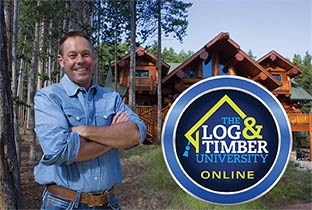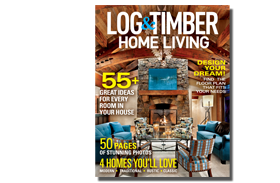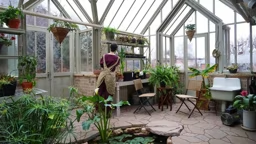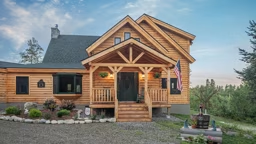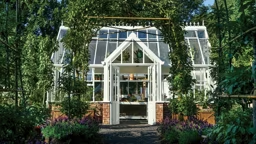Wildfire protection for your log home starts with a smart landscaping plan. If you design your landscape with wildfire safety in mind, you can create a beautiful landscape that can help contain fire instead of fuel it. It’s all a matter of choosing the right materials, plants, shrubs and trees, then spacing them properly and taking good care of them.
You can use driveways, walkways, patios and water features to add interest and reduce fire danger. See your state forest or county website for recommendations on fire-resistant plants that do well in your area. There are also links to local plant lists provided by the Cooperative Extension Services of many states listed on the Firewise® website.
It’s important to maintain your landscape to keep it in fire-resistant condition. That means pruning, weeding, mowing, trimming dead branches and removing dead and dried plants. If water — or the lack thereof — is a perennial issue, consider using non-woody native plants that require little irrigation, and incorporating features like walkways, patios, stone walls and boulderscapes that need little care and actually improve your defensibility.
Wildfire protection is an ongoing maintenance process. Something as seemingly innocent as a forgotten basket of clippings that have dried out in the sun or wheelbarrow of firewood left too close to the house can turn into a deadly ignition source in seconds.
Upwards of a quarter of the homes built in the Wildland Urban Interface Zone (WUI) are second homes. If yours is one of them and you don’t have someone regularly doing maintenance, err on the side of too much defensible space, and make your ignition zone as maintenance free and spark-proof as you possibly can.
 Zone One (the first 30 feet) applies to all homes in the WUI. Zone Two (30 to 100 feet) applies to homes in moderate- to high-hazard areas. Zone Three (100 to 200 feet) is for high-hazard areas. (Courtesy of the NFPA Firewise Communities Program)
Zone One (the first 30 feet) applies to all homes in the WUI. Zone Two (30 to 100 feet) applies to homes in moderate- to high-hazard areas. Zone Three (100 to 200 feet) is for high-hazard areas. (Courtesy of the NFPA Firewise Communities Program)
Zone One: 0 to 30 Feet (for all homes in the WUI)
Zone One is typically defined as 30 feet in all directions from your house and any attached structures such as decks, garages and storage buildings, as well as any trees next to the house you are incorporating into your defensible space. Experts recommend that everyone in the WUI create a Firewise Zone 1 regardless of your hazard-area rating.
 The fire-free five: keep a five-foot area surrounding your house free from flammable items.
The fire-free five: keep a five-foot area surrounding your house free from flammable items.
Fire-Free Five.
Make a minimum of the first five feet surrounding your house totally free of anything flammable. Use fire-resistant landscaping materials such as rock mulch (bark and chip mulch become flammable when dry) or stone walkways, or plant high moisture content annuals or perennials.
Five to 30 feet.
Choose plants that are low growing and don’t contain waxes, resins and oils that burn easily. Group and space plantings so they don’t create a continuous path for the fire.
• Trim tree branches that overhang the house.
• Trim trees branches up 6 to 10 feet from the ground; this prevents the lower branches from serving as ladders for the fire to climb.
• Space conifer trees so there is 30 feet between crowns. If you plan to cut down trees around your home to improve your defensible space choose wisely: conifers, pines, evergreens, firs and eucalyptus will catch on fire faster than hardwood trees.
• Keep your grass watered and mowed. A well-watered lawn can serve as a fire break. A dry, overgrown lawn can serve as a fire path. If you live in an arid climate or have to deal with frequent water restrictions, consider xeriscaping with rock and fire-resistant, drought-tolerant plants and groundcovers.
• Remove any dead vegetation from under decks and within ten feet of the house. Once you’ve screened in the space below your deck, you’ll have an easier time keeping blowing leaves and debris out. But it will probably still pile up when the wind blows, so make a habit of walking your perimeter regularly during fire season.
• Locate propane tanks and woodpiles outside this zone.
Zone Two: 30 to 100 Feet (for Moderate and High Hazard Areas)
• Use plantings that are low-growing, well-irrigated and less flammable.
• Trees should be clustered in groups of two or three with 30 feet between clusters; leave 20 feet between individual trees.
• Prune lower branches up 6 to 10 feet from the ground.
• Encourage a mix of deciduous and coniferous trees if your climate permits.
• Create fire breaks with walkways, lawns, water features, rock gardens, rock patios and gravel or paved driveways.
Zone Three: 100 to 200 Feet (for High Hazard Areas)
Reduce density in this area by thinning and creating more space between trees. Prune tall trees so the crowns (tops) don’t touch. Remove small conifers growing in between larger trees—they provide ladder fuel. If you have several acres or more, you might want to consult a forester about the smartest way to thin.
Some studies show that thinning for thinning’s sake can actually make it easier for a surface fire to spread. The best approach to wildfire protection is to execute a plan that takes typical fire behavior during dry and windy conditions into account rather than just thin to an arbitrary density.
